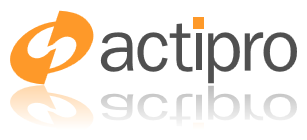ReflectionContentControl
The ReflectionContentControl is a regular ContentControl however it also renders a reflection effect of the content below the actual content. This reflection effect has become quite popular in recent user interfaces.

The ReflectionContentControl control providing reflection effects on the Actipro logo
You have total control over the size, distance, and visual characteristics of the reflection. You can even skew the reflection to an angle.
Tip
Animate the ReflectionMargin property along with the RenderTransform of the ReflectionContentControl to create a bounce effect. This is demonstrated in the sample project.
A reflection effect like what is provided in this control can be implemented from scratch in XAML however it takes many lines of code to do so. Instead, just wrap your content with a ReflectionContentControl and you're done.
The ReflectionContentControl class has these important members:
| Member | Description |
|---|---|
| ReflectionEndOffset Property | Gets or sets the offset at which the end opacity (least opaque) is located in the reflection. The default value is 0.9. |
| ReflectionEndOpacity Property | Gets or sets the opacity of the reflection at its ending (least opaque) point. The default value is 0.0, meaning transparent. |
| ReflectionHeight Property | Gets or sets the height of the reflection. The default value is NaN, meaning that the height will be the same height as the content. |
| ReflectionMargin Property | Gets or sets the margin distance between the content and the reflection. The default value is 0. |
| ReflectionSkewAngleX Property | Gets or sets the skew angle of the reflection in the x-plane. The default value is 0, meaning no skew is applied. |
| ReflectionStartOpacity Property | Gets or sets the opacity of the reflection at its starting (most opaque) point. The default value is 0.4, meaning 40% opaque. |